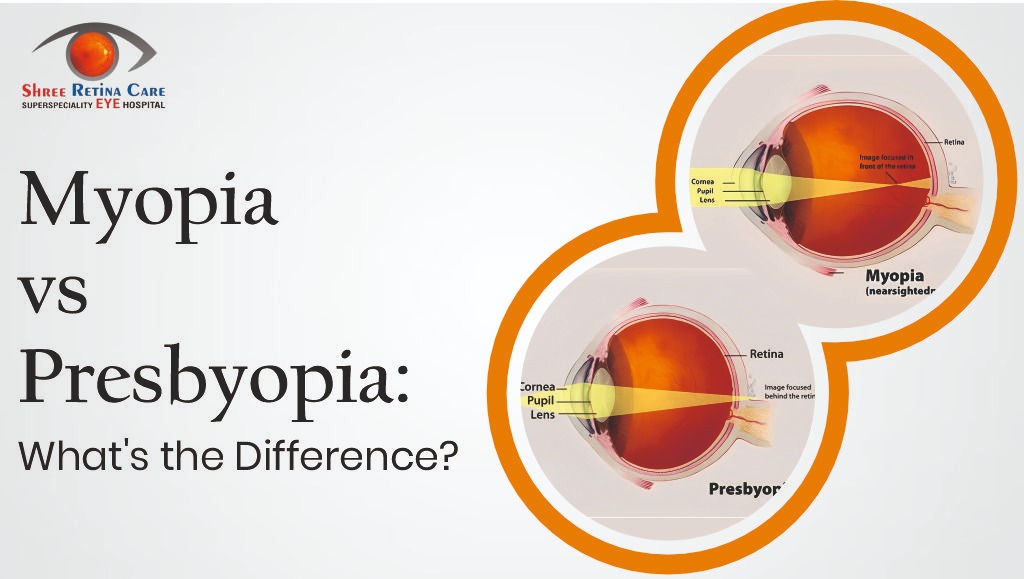Presbyopia vs Myopia: Understanding the Difference
Vision problems are among the most common health concerns worldwide, and two of the most frequently discussed are presbyopia and myopia. While both conditions affect how clearly you see, they are entirely different in their causes, symptoms, and treatment options. If you’ve ever wondered about the difference between presbyopia disease and myopia correction, this article will guide you through everything you need to know—from meaning and causes to treatments and prevention.
What is Myopia?
Myopia, often called nearsightedness, is a refractive error where close objects appear clear, but distant objects look blurry.
Causes of Myopia
- The eyeball is too long, or the cornea is too curved.
- Light focuses in front of the retina instead of directly on it.
- Can be genetic or influenced by lifestyle (prolonged screen time, less outdoor activity).
Symptoms of Myopia
- Blurry distance vision
- Squinting to see clearly
- Eye strain and headaches
- Difficulty seeing road signs or classroom boards
What is Presbyopia?
Presbyopia disease is an age-related condition that typically begins around the age of 40. Unlike myopia, it isn’t caused by the shape of the eye but by the natural stiffening of the eye’s lens.
Causes of Presbyopia
- The eye’s lens loses elasticity with age.
- The muscles around the lens weaken, making it harder to focus on nearby objects.
- Unlike myopia, it affects almost everyone eventually.
Symptoms of Presbyopia
- Difficulty reading small print (menus, books, phone screens)
- Holding reading material farther away
- Eye strain during close work
- Headaches after near tasks
Key Differences Between Presbyopia and Myopia
| Feature | Myopia (Nearsightedness) | Presbyopia (Age-related farsightedness) |
| Cause | Elongated eyeball / curved cornea | Aging lens loses elasticity |
| Age of Onset | Common in children & young adults | Usually after age 40 |
| Vision Issue | Blurry distance vision | Difficulty with near vision |
| Progression | Can worsen with age until stabilizing | Gradually worsens with age |
| Correction | Myopia correction through glasses, contacts, LASIK | Presbyopia and correction with reading glasses, bifocals, multifocals, or surgery |
Also read: Myopia vs Hypermetropia
Treatment Options for Presbyopia
1. Reading Glasses
Simple reading glasses are the most common solution, especially if you don’t have other vision problems. They’re available over-the-counter or as custom eye prescription glasses.
2. Bifocals or Multifocals
For those already wearing prescription glasses, bifocals or progressive lenses combine distance and near correction in one pair.
3. Contact Lenses
Special contact eye designs like multifocal lenses help with both near and distance vision. Today, you can buy online contact lenses or contacts online in different strengths for presbyopia.
4. Surgical Options
- Corneal inlays: A small implant inserted into the cornea.
- Lens replacement surgery: The aging lens is replaced with an artificial intraocular lens.
- Some cases combine laser eye surgery for eyesight with lens procedures.
Preventive Measures for Healthy Eyes
While you can’t prevent presbyopia disease, you can slow down the progression of myopia and reduce eye strain:
- Take regular breaks from screens (20-20-20 rule)
- Spend more time outdoors (especially for children)
- Use proper lighting for reading
- Schedule yearly eye exams with an eye doctor.
Conclusion
Both presbyopia and myopia affect vision, but they arise from very different causes. Myopia correction focuses on reshaping how the eye bends light for distance vision, while presbyopia and correction involve compensating for the natural aging of the lens.
Whether you need reading glasses, eye glasses prescription glasses, contact lenses, or even LASIK eye surgery, modern eye and eye care offers multiple solutions.
The key takeaway? Don’t self-diagnose. Schedule regular eye exams with your eye doctor to catch these issues early and explore treatment options—from eye glasses online and order contact lenses online to advanced laser eye surgery for eyesight.

